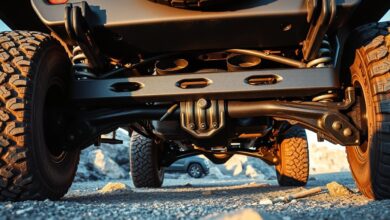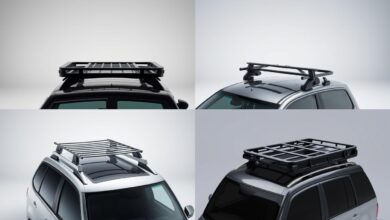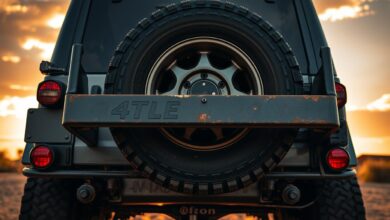Why Every 4WD Needs a Set of Reliable Recovery Tracks
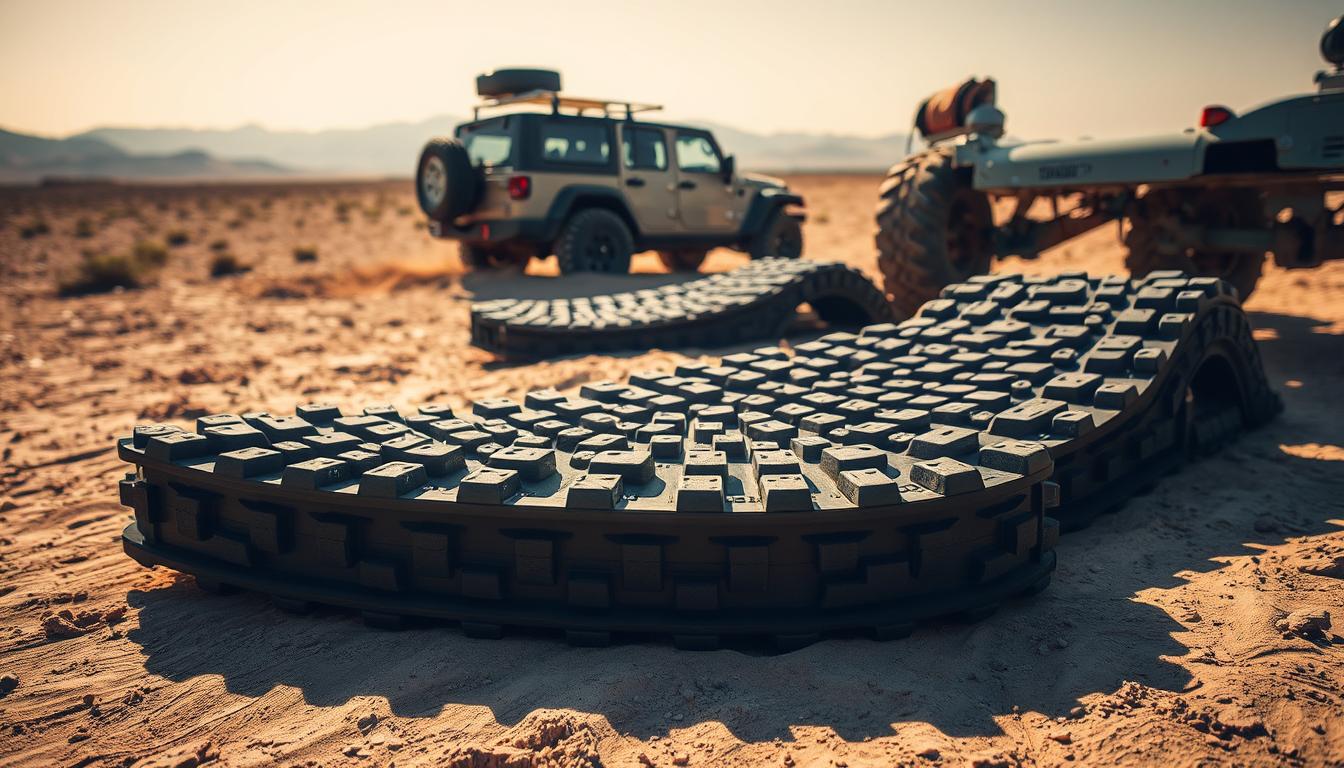
Ever found yourself stuck in the mud or stranded in a remote area while off-roading? It’s a situation no adventurer wants to be in. But, the right equipment can help avoid it.
For 4WD enthusiasts, reliable off-road recovery tracks are key. They are essential recovery gear for 4×4 vehicles. They can save you, letting you recover your vehicle by yourself.
With must-have recovery tracks for off-roading, you can explore remote areas with confidence. You’ll be ready for any unexpected situations.
Key Takeaways
- Reliable recovery tracks are a must-have for 4WD enthusiasts who venture off-road.
- They enable you to recover your vehicle without needing manpower.
- Having the right equipment can mitigate the risk of getting stuck.
- Off-road recovery tracks are essential for safe and enjoyable off-roading.
- They provide confidence when exploring remote areas.
Understanding Recovery Tracks and Their Importance
Recovery tracks are key for off-roaders. They help get your 4WD out of tough spots. Whether it’s mud, sand, or rocks, these tracks can make all the difference.
What Are Recovery Tracks?
Recovery tracks are special tools for tires stuck in hard terrain. They’re made tough, like Maxtrax recovery boards, to handle off-road challenges.
The Role of Recovery Tracks in Off-Roading
Recovery tracks help pull a stuck vehicle out. They give tires the grip needed to move forward. This prevents damage and keeps you safe from accidents.
“Recovery tracks are a must-have for serious off-roaders,” says experts. They’re ready for the tough terrains you’ll face.
Knowing the types of recovery tracks, like plastic or metal, helps a lot. The right tracks mean you’re ready for any terrain.
Benefits of Having Recovery Tracks in Your 4WD
Recovery tracks are essential for any 4WD vehicle. They offer many benefits for those who love off-roading. Whether you’re dealing with mud, steep hills, or sandy dunes, recovery tracks can help you stay on track.
Increased Safety While Off-Roading
Recovery tracks make off-roading safer. They give your vehicle more grip and stability. This helps prevent accidents and keeps your vehicle from getting stuck or damaged.
They also make it easier to get your vehicle unstuck. This reduces the need for risky recovery methods. For more tips on using recovery tracks, check out this resource.
Enhancing Recovery Capabilities
Recovery tracks boost your vehicle’s ability to get out of tough spots. They provide extra grip in sandy or muddy conditions. This lets your vehicle move more easily.
They also work well with other recovery tools, like winches. This makes them a must-have for serious off-roaders.
Preventing Damage to Your Vehicle
Recovery tracks also protect your vehicle from damage. They offer a safe way to recover, reducing harm to tires, wheels, and suspension. This is key when facing tough recovery situations.
They also spread out the force of recovery. This reduces stress on your vehicle’s parts. This helps your vehicle last longer and perform better.
Types of Recovery Tracks Available
Off-road recovery just got easier with the variety of recovery tracks available for 4×4 vehicles. When venturing into challenging terrains, having the right recovery tracks can be the ultimate recovery solution for 4×4 vehicles.
Plastic vs. Metal Recovery Tracks
Recovery tracks are made from different materials, mainly plastic and metal. Maxtrax recovery boards, for example, are made from reinforced nylon. They are compact and lightweight. Metal recovery tracks, on the other hand, offer greater durability and strength, suitable for heavier vehicles.
When choosing between plastic and metal, think about the terrain and your vehicle’s weight. Plastic tracks are often more portable. Metal tracks provide enhanced grip and stability.
Different Designs and Their Uses
Various designs cater to specific recovery needs. Some recovery tracks have a particular tread pattern for better grip on muddy or sandy surfaces. Others are engineered for use on rocky or steep terrains.
Understanding the design and its intended use will help you select the most appropriate recovery tracks for your off-roading adventures.
Popular Brands to Consider
Several brands have made a name for themselves in the recovery tracks market. Brands like Maxtrax and ARB are well-regarded for their quality and performance. When selecting a brand, consider factors such as durability, ease of use, and customer reviews.
Researching and comparing different brands will ensure you find the best off-road recovery tracks that suit your needs.
How to Choose the Right Recovery Tracks
Choosing the right recovery tracks for your 4WD is key for safe off-roading. There are many options out there. Knowing what to look for can help you make a smart choice.
Weight Capacity Considerations
When picking recovery tracks, weight capacity is a big deal. It’s crucial to pick tracks that can handle your vehicle’s weight. If the tracks can’t handle your vehicle’s weight, they might fail. This could lead to dangerous situations.
Always check the manufacturer’s specs. Make sure the tracks match your 4WD’s Gross Vehicle Mass (GVM).
Terrain-Specific Features
Different terrains need different recovery tracks. For muddy or sandy areas, you need tracks with aggressive tread patterns for better grip. On rocky terrains, durability and resistance to abrasion are more important.
Think about where you usually go off-roading. Choose tracks that fit your needs.
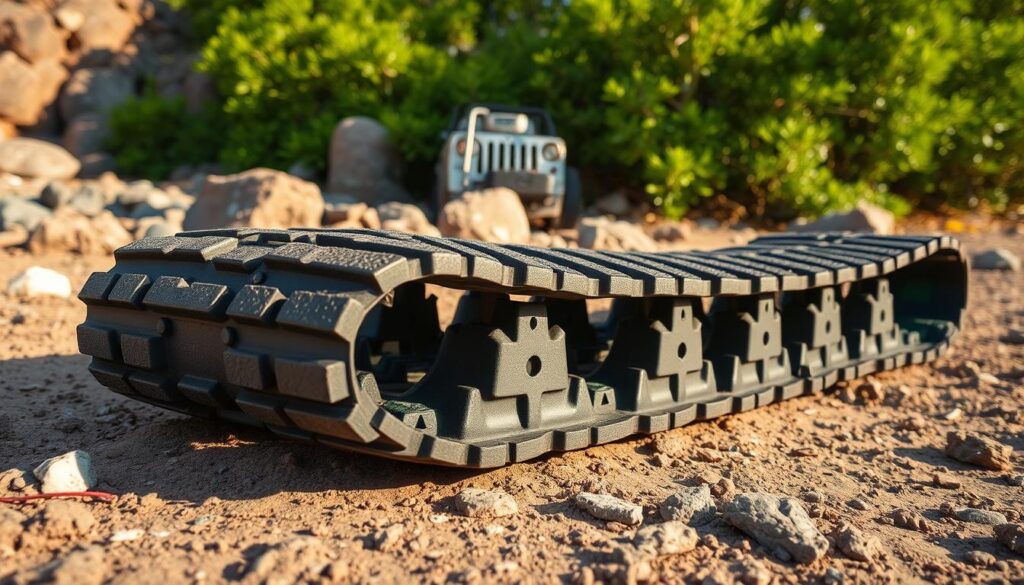
Price and Quality Comparison
It’s tempting to go for the cheapest tracks. But, quality is more important. High-quality recovery tracks might cost more upfront. But, they save you money in the long run by lasting longer.
Look at products from trusted brands. Read reviews from other off-roaders to see how well the tracks perform.
| Brand | Weight Capacity | Terrain Suitability | Price Range |
|---|---|---|---|
| ARB | Up to 5,000 kg | Mud, Sand, Rock | $150-$250 |
| Maxwinch | Up to 4,000 kg | Mud, Sand | $100-$200 |
| Recovery Solutions | Up to 6,000 kg | Rock, Mud, Sand | $200-$350 |
By looking at these factors and comparing options, you can find the best recovery tracks for your 4WD. This ensures you’re ready for any off-roading adventure.
Proper Usage of Recovery Tracks
Recovery tracks are more than just a tool; they’re a lifeline when you’re stuck. Knowing how to use them right is key. Whether you’re tackling muddy trails or sandy dunes, using must-have recovery tracks for off-roading correctly can mean the difference between getting out and being stuck.
Tips for Setting Up Recovery Tracks
Setting up recovery tracks needs careful attention for safe and effective use. First, pick a firm and stable anchor point on both vehicles. The tracks should be securely attached to the stuck vehicle’s tow hook and the rescuing vehicle’s tow hook or frame. Always follow the manufacturer’s instructions for attachment and check that all connections are tight and secure.
Best Practices for Safe Recovery
Safe recovery practices are essential when using recovery tracks. Keep bystanders away from the recovery operation. Use warning lights or flags to alert other trail users. Recover the vehicle slowly and smoothly to avoid jerking the tracks or causing more damage. Use durable recovery tracks for outdoor enthusiasts that can handle the stresses of recovery.
For more detailed information on recovery tracks, visit https://unsealed4x4.com.au/everything-you-need-to-know-about-recovery-tracks/. Learn about different types and their uses.
Common Mistakes to Avoid
One common mistake is attaching tracks to weak or wrong anchor points. This can cause tracks to fail or damage the vehicle. Another error is not keeping a safe distance during recovery, risking injury from snapping tracks or equipment failure. Always check your recovery tracks before use for wear or damage. Replace them if needed for safe and effective recovery.
Maintenance Tips for Your Recovery Tracks
Keeping your recovery tracks in top shape is key. They need to be ready for action at all times. Proper care ensures they last longer and perform better.
Cleaning and Storage Recommendations
Always clean your recovery tracks after each use. Experts say using a pressure washer is best for getting rid of dirt. Then, store them in a dry spot, out of the sun, to avoid damage.
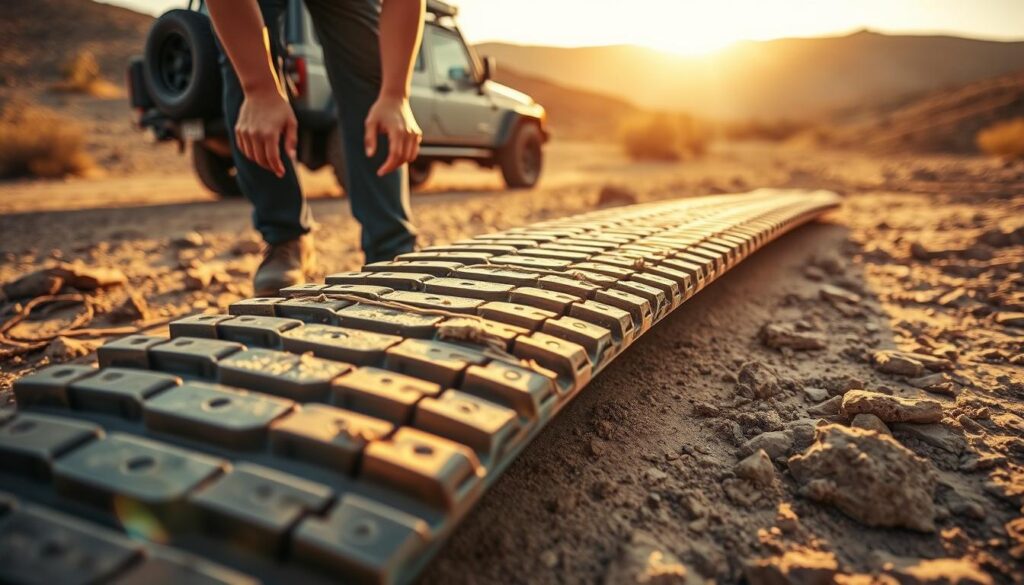
Inspecting for Damage Regularly
It’s important to check your recovery tracks often. Look for cracks, frays, or any damage. Spotting problems early can stop bigger issues later.
When to Replace Your Recovery Tracks
Knowing when to replace your tracks is just as important as keeping them up. Look for deep cracks or broken strands. If they’ve been in harsh conditions, check them after use.
| Maintenance Task | Frequency | Importance Level |
|---|---|---|
| Cleaning | After each use | High |
| Inspection | Monthly | High |
| Storage Check | Quarterly | Medium |
| Replacement | As needed | High |
For more tips on using recovery gear, check out this guide on recovery boards. It offers great advice on using and caring for your recovery equipment.
Recovery Tracks vs. Other Recovery Methods
Recovery tracks are key for off-road fans, but how do they stack up against other methods? The right gear is essential for tackling tough terrains. We’ll look at how recovery tracks compare to other options, focusing on their effectiveness, cost, and when to use them.
Comparing Recovery Tracks to Winches
Winches and recovery tracks are both popular among off-roaders. Yet, they’re used for different reasons. Winches help a vehicle pull itself out of trouble. Recovery tracks, though, are for helping another vehicle get unstuck. Recovery tracks offer a stable way to pull a vehicle to safety, if done right.
Winches are best for when a vehicle is stuck and needs to pull itself out. Recovery tracks are better for when another vehicle is needed to help. Choosing between a winch or recovery tracks depends on the recovery situation.
The Cost-Effectiveness of Tracks
Recent data shows recovery tracks are a cost-effective way to recover vehicles. They’re a one-time buy with little upkeep, appealing to those who off-road often. Unlike winches, which need extra gear, tracks are easy to use and save money.
Tracks are also durable and versatile. They work well in mud, sand, and snow, making them a great addition to any off-road kit.
Situations Best Suited for Tracks
Recovery tracks shine when a vehicle is stuck in tough terrain and needs help from another. They’re perfect for mud, sand, and snow, providing a safe way to recover. They’re also good for vehicles that can’t be winched much, spreading the recovery force evenly.
In summary, recovery tracks are a reliable and affordable choice for off-road recovery. Knowing their benefits and when to use them helps off-road fans choose the right gear.
Real-Life Scenarios: When Recovery Tracks Save the Day
Recovery tracks have saved many off-roaders in tough situations. They are a reliable way to get out of tricky spots. Whether you’re experienced or new, knowing the value of recovery tracks is key to your adventures.
Overcoming Mud and Sand Challenges
Mud and sand are tough for off-roaders. The risk of getting stuck is high. But, must-have recovery tracks for off-roading make it easy to get unstuck. For example, in the Australian Outback, a group got stuck in deep mud.
Assistance During Snowy Conditions
Snowy conditions are challenging for off-roaders. The cold and slippery terrain is dangerous. But, recovery tracks help adventurers move through snow.
A group of snowmobile enthusiasts used recovery tracks to rescue a stranded friend.
Examples from Off-Road Enthuisasts
Many off-road fans rely on recovery tracks. They share stories of how these tools saved them from bad situations. Here’s a look at different recovery track features from off-road enthusiasts:
| Feature | Brand A | Brand B |
|---|---|---|
| Material | High-strength nylon | Durable polyester |
| Weight Capacity | 5,000 kg | 4,500 kg |
| Price | $150 | $120 |
Different brands offer various features for off-road enthusiasts. The right durable recovery tracks for outdoor enthusiasts depend on your needs and the terrain you face.
Legal and Environmental Considerations
When you’re out with your 4WD, knowing the legal and environmental rules is key. Recovery tracks are more than just gear; they’re part of safe and green off-roading.
Off-Roading Regulations in the U.S.
In the U.S., off-roading laws differ by state. It’s essential to know the local rules before you go. This includes any permits needed, where you can’t go, and rules for recovery gear.
Respecting Nature While Recovering Vehicles
When you’re recovering your vehicle, try not to harm the environment. Avoid damaging plants or disturbing animals. Using high-quality recovery tracks can help lessen your impact.
Responsible Off-Roading Practices
Good off-roading isn’t just about following the law; it’s about keeping nature beautiful. Stick to the trails, don’t litter, and respect other users. This helps keep off-roading sustainable for all.
By following these tips, you can have fun off-roading while protecting nature. Getting the right essential recovery gear for 4×4 vehicles is part of being responsible. It prepares you for any challenge.
Investing in Recovery Tracks: Cost vs. Value
Deciding to buy recovery tracks depends on their value compared to the cost. For many off-road fans, these tracks are essential. They ensure safety and reliability on adventures.
Evaluating Your Off-Road Frequency
Before buying top performance recovery tracks, think about how often you go off-roading. If you’re not off-roading much, the cost might be too high. But, if you often tackle tough terrains, these tracks are vital. They boost safety and lower the chance of getting stuck.
Think about the terrains you usually drive on. For example, if you often drive on mud or sand, recovery tracks are a must. They give the grip needed to pull your vehicle out of tough spots. This could save you from expensive repairs or towing costs.
Long-Term Financial Benefits
The initial cost of recovery tracks might seem steep, but they save money in the long run. They help avoid damage to your vehicle during recoveries, saving on repair bills. Plus, they might cut down on the need for pricey recovery services.
“Investing in recovery tracks is like buying insurance for your off-roading adventures. It’s a precautionary measure that can save you a lot in the long run.”
For those who off-road often, the cost of recovery tracks can be worth it. They protect your vehicle’s value and keep you safe.
Resale Value and Longevity
Recovery tracks can also boost your 4WD’s resale value. A good set of tracks shows your vehicle is ready for off-road adventures. This is attractive to buyers who love off-roading too.
To pick the best recovery tracks for your 4WD, check out specialized gear comparison sites. They help you choose based on your needs and budget.
In summary, while recovery tracks cost money, their value is in safety, reliability, and long-term savings. By considering your off-road habits and the benefits they offer, you can decide wisely on the best recovery tracks for your 4WD.
Conclusion: Making Recovery Tracks Essential Gear
When you go off-road, having the right gear is key. Off-road recovery tracks are a must for any 4WD fan. They help you get out of tough spots safely.
Maxtrax recovery boards are a great example of essential gear. They make a big difference in getting your vehicle out of trouble. With reliable recovery tracks, you can avoid damage and enjoy your drive more.
Safety and Preparedness
Having recovery tracks in your 4WD is a smart safety move. It prepares you for the unexpected. This way, you can have fun off-roading without worry.
Take the Next Step
Don’t wait until you’re stuck to think about recovery. Get recovery tracks for your 4WD now. It’s a smart move for any off-roader, whether you’re new or experienced.
FAQ
What are recovery tracks and how do they work?
Recovery tracks, also known as recovery boards, help get a stuck vehicle moving. They give the tires a solid surface to grip. This allows the vehicle to drive out of tough terrain.
What are the benefits of using recovery tracks for4WD vehicles?
Recovery tracks make off-roading safer and boost recovery power. They also protect your vehicle from damage. They’re great for sandy, muddy, or snowy terrains.
What types of recovery tracks are available in the market?
You can find plastic and metal recovery tracks. Maxtrax recovery boards are popular for being light and strong. Metal tracks offer even more strength and durability.
How do I choose the right recovery tracks for my4WD vehicle?
Look at the weight capacity, terrain features, and price. Make sure they match your vehicle’s weight and the terrain you’ll face.
How do I properly use recovery tracks?
Follow the manufacturer’s setup guide. Place the tracks on a firm surface. Use them with a winch or other methods if needed.
What are some common mistakes to avoid when using recovery tracks?
Don’t pick the wrong tracks for the terrain. Always follow the manufacturer’s guide. Check for damage before use.
How do I maintain my recovery tracks?
Clean and store them right after use. Regularly check for damage. Replace them when needed. This keeps them in good shape.
Are recovery tracks a cost-effective recovery solution?
Yes, they’re cost-effective compared to winches. They’re also a key part of your 4WD’s safety and recovery kit.
Can recovery tracks be used in all types of terrain?
You can use them in sand, mud, and snow. But, their success depends on the terrain and the tracks’ type.
Are there any legal or environmental considerations when using recovery tracks?
Always respect the environment and follow off-roading rules. Avoid sensitive areas and don’t damage the terrain.
How do recovery tracks compare to other recovery methods, such as winches?
Tracks and winches have different uses. Tracks provide traction, while winches pull a vehicle out of tough spots.
What is the resale value of recovery tracks?
High-quality tracks keep their value and can be resold. Proper care and storage help maintain their condition and value.

